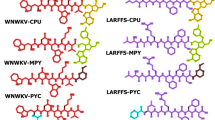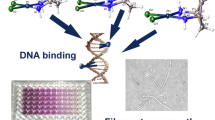Abstract
Thiotepa (N,N′,N″-triethylenethiophosphoramide) and its major metabolite (Tepa) as trifunctional alkylating agents has recently been used in cancer therapy. In vivo and vitro studies show the possible pathways of alkylation of DNA by Thiotepa and Tepa. Two pathways are suggested, but the main pathway of mechanism remains unclear. In pathway 1, forming cross-links with DNA molecules can be carried out via two different mechanisms. In first mechanism, these agents undergo the ring opening reaction which is initiated by protonating aziridine, which then becomes the main target of nucleophilic attack by the N7-Guanine of DNA. The second probable mechanism is ring opening of aziridyl group by nucleophilic attack of N7-Guanine without initial protonation. Thiotepa and Tepa in pathway 2, act as a cell penetrating carrier for aziridine, which is released via hydrolysis. The released aziridine can form a cross-link with N7-Guanine. In this study, we calculated the activation free energy and kinetic rate constant for alkylating the Guanine via the first pathway to determine the most precise mechanism by applying density functional theory using B3LYP method. We carried out geometrical optimizations with the conductor-like polarizable continuum model to account for the solvent effect, and the results were compared with those in the gas phase. Hyperconjugation stabilization factors that affect on stability of generated transition state were investigated by natural bond order analysis. Furthermore, quantum theory of atoms in molecules analysis was performed to extract the bond critical points properties because the electron densities can be considered as a good description of the strength of different types of interactions.








Similar content being viewed by others
References
Katzung BG (1998) Basic and clinical pharmacology, 7th edn. Prentice Hall, Englewood Cliffs, NJ
Benigni R, Bossa C (2010) Mechanisms of chemical carcinogenicity and mutagenicity: a review with implications for predictive toxicology. Chem Rev 111:2507–2536
Pullman B (1980) Carcinogenesis: fundamental mechanisms and environmental effects. D Reidel, Dordrecht, pp 51–55
Sykes M, Karnofsky D, Phillips F, Burchenal JH (1953) Clinical studies of triethylene-phosphoramide and diethylene-phosphoramide compounds with nitrogen mustard-like activity. Cancer 6:142–148
Van der Wall E, Beijnen JH, Rodenhuis S (1995) High-dose chemotherapy regimens for solid tumors. Cancer Treat Rev 21:105–132
Mellet LB, Woods LA (1960) The comparative physiological disposition of thiotepa and tepa in the dog. Cancer Res 20:524–532
Van Maanen MJ, Smeets CJM, Beijnen JH (2000) Chemistry, pharmacology and pharmacokinetics of N,N’,N”-triethylenethiophosphoramide (ThioTEPA). Cancer Treat Rev 26:257–268
Van Maanen MJ, Tijhof IM, Damen JMA et al (1999) A search for new metabolites of N,N′,N″-triethylenethiophosphoramide. Cancer Res 59:4720–4724
Van Maanen MJ, Doesburg Smits K, Damen JMA et al (2000) Stability of Thiotepa and its metabolites, TEPA, monochloroTEPA and thioTEPA-mercapturate, in plasma and urine. Int J Pharm 200:187–194
Musser SM, Pan SS, Egorin MJ et al (1992) Alkylation of DNA with aziridine produced during the hydrolysis of N,N’,N’’-triethylenethiophosphoramide. Chem Res Toxicol 5:95–99
Hemminki K (1984) Reactions of ethyleneimine with guanosine and deoxyguanosine. Chem Biol Interact 48:249–260
Hunt CA, MacGregor RD, Siegal RA (1986) Engineering targeted in vivo drug delivery I. The physiological & physicochemical principles governing opportunities & limitations. Pharm Res 3:333–344
Segerback D, Calleman CJ, Schroeder JL, Costa LG, Faustman EM (1995) Formation of N-7-(2-carbamoyl-2-hydroxyethyl) guanine in DNA of the mouse and the rat following intraperitoneal administration of [14C] acrylamide. Carcinogenesis 16:1161–1165
Gamboa da Costa G, Churchwell MI, Hamilton LP, Von Tungeln LS, Beland FA, Marques MM (2003) DNA adduct formation from acrylamide via conversion to glycidamide in adult and neonatal mice. Chem Res Toxicol 16:1328–1337
Johnson WW, Guengerich FP (1997) Reaction of aflatoxin B1 exo-8,9-epoxide with DNA: kinetic analysis of covalent binding and DNA-induced hydrolysis. Proc Natl Acad Sci USA 94:6121–6125
Twaddle NC, McDaniel LP, Gamboa da Costa G, Churchwell MI, Beland FA, Doerge DR (2004) Determination of acrylamide and glycidamide serum toxicokinetics in B6C3F1 mice using LC-ES/MS/MS. Cancer Lett 207:9–17
Warshel A (1991) Computer modeling of chemical reactions in enzymes and solutions. Wiley, New York
Miertus S, Scrocco E, Tomasi J (1981) Electrostatic interaction of a solute with a continuum. A direct utilization of ab initio molecular potentials for the prevision of solvent effects. Chem Phys 55:117–129
Spartan’06V102’ Wavefunction Inc., Irvine
Becke AD (1993) Density-functional thermochemistry. III. The role of exact exchange. J Chem Phys 98:5648–5652
Lee C, Yang W, Parr RG (1988) Development of the Colle-Salvetti correlation-energy formula into a functional of the electron density. Phys Rev B 37:785–789
Cossi M, Barone V, Mennucci B, Tomasi J (1998) Ab initio study of ionic solutions by a polarizable continuum dielectric model. Chem Phys Lett 286:253–260
Cossi M, Rega N, Scalmani G, Barone V (2003) Energies, structures, and electronic properties of molecules in solution with the C-PCM solvation model. J Comput Chem 24:669–681
Sevastik R, Himo F (2007) Quantum chemical modeling of enzymatic reactions: the case of 4-oxalocrotonate tautomerase. J Bioorg Chem 35:444–457
Georgieva P, Himo F (2008) Density functional theory study of the reaction mechanism of the DNA repairing enzyme alkylguanine alkyltransferase. Chem Phys Lett 463:214–218
Chen S, Fang w, Himo F (2008) Technical aspects of quantum chemical modeling of enzymatic reactions: the case of phosphotriesterase. Theor Chem Account 120:515–522
Himo F, Guo J, Rinaldo-Matthis A, Nordlund P (2005) Reaction mechanism of deoxyribonucleotidase: a theoretical study. J Phys Chem B 109:20004–20008
Pliego JR (2004) Basic hydrolysis of formamide in aqueous solution: a reliable theoretical calculation of the activation free energy using the cluster-continuum model. Chem Phys 306(1–3):273–280
Stare J, Henson NJ, Eckert J (2009) Mechanistic aspects of propene epoxidation by hydrogen peroxide. Catalytic role of water molecules, external electric field, and zeolite framework of TS-1. J Chem Inf Model 49(4):833–846
Nguyen MT, Raspoet G, Vanquickenborne LG (1999) Necessity to consider a three-water chain in modelling the hydration of ketene imines and carbodiimides. J Chem Soc 4:813–820
Reed AE, Weinhold F (1985) Natural localized molecular orbitals. J Chem Phys 83:1736–1740
Reed AE, Weinstock RB, Weinhold F (1985) Natural population analysis. J Chem Phys 83:735–746
Reed AE, Weinhold F (1983) Natural bond orbital analysis of near‐Hartree–Fock water dimer. J Chem Phys 78:4066–4073
Foster JP, Weinhold F (1980) Natural hybrid orbitals. J Am Chem Soc 102:7211–7218
Chocholousova J, Vladimir Spirko V, Hobza P (2004) First local minimum of the formic acid dimer exhibits simultaneously red-shifted O–H···O and improper blue-shifted C–H···O hydrogen bonds. Phys Chem Chem Phys 6:37–41
Reed AE, Curtiss LA, Weinhold F (1988) Intermolecular interactions from a natural bond orbital, donor–acceptor viewpoint. Chem Rev 88:899–926
Bader RFW (2002) AIM2000 program package, Ver. 2.0. McMaster University, Hamilton
Bader RFW (1998) Bond path: a universal indicator of bonded interactions. J Phys Chem A 102:7314–7323
Bader RFW (1990) Atoms in molecules. A quantum theory. Clarendon, Oxford
Pakiari AH, Eskandari K (2006) The chemical nature of very strong hydrogen bonds in some categories of compounds. J Mol Struct 759:51–60
Abboud JLM, Mó O, De Paz JLG et al (1993) Thiocarbonyl versus carbonyl compounds: a comparison of intrinsic reactivities. J Am Chem Soc 115:12468–12476
Hocquet A (2001) Intramolecular hydrogen bonding in 2′-deoxyribonucleosides: an AIM topological study of the electronic density. Phys Chem/Chem Phys 3:3192–3199
Rozas I, Alkorta I, Elguero J (2000) Behavior of ylides containing N, O, and C atoms as hydrogen bond acceptors. J Am Chem Soc 122:11154–11161
Kheffache D, Oumerali O (2010) Some physicochemical properties of the antitumor drug Thiotepa and its metabolite Tepa as obtained by density functional theory (DFT) calculations. J Mol Model 16:1383–1390
Barone V, Cossi M (1998) Quantum Calculation of Molecular Energies and Energy Gradients in Solution by a Conductor Solvent Model. Phys Chem A 102(11):1995–2001
Cammi R, Mennucci B, Tomasi J (1999) Second-Order Møller-Plesset Analytical Derivatives for the Polarizable Continuum Model Using the Relaxed Density Approach. Phys Chem A 103(45):9100–9108
Klamt A, Schüürmann G (1993) COSMO: a new approach to dielectric screening in solvents with explicit expressions for the screening energy and its gradient. Chem Soc, Perkin Trans 2:799–805
Tomasi J, Mennucci B, Cammi R (2005) Quantum Mechanical Continuum Solvation Model. Chem Rev 105(8):2999–3094
Acknowledgment
Support from Sharif University of Technology is gratefully acknowledged. We thank Z. Aliakbar Tehrani, M. Jebeli Javan and M. Shakourian-Fard, Ph.D. students of Physical Organic Chemistry Laboratory at Sharif University of Technology.
Author information
Authors and Affiliations
Corresponding author
Electronic supplementary material
Below is the link to the electronic supplementary material.
Rights and permissions
About this article
Cite this article
Torabifard, H., Fattahi, A. DFT study on Thiotepa and Tepa interactions with their DNA receptor. Struct Chem 24, 1–11 (2013). https://doi.org/10.1007/s11224-012-0020-4
Received:
Accepted:
Published:
Issue Date:
DOI: https://doi.org/10.1007/s11224-012-0020-4




